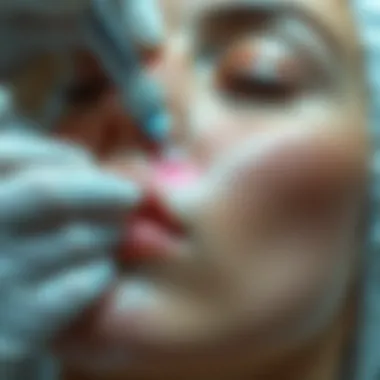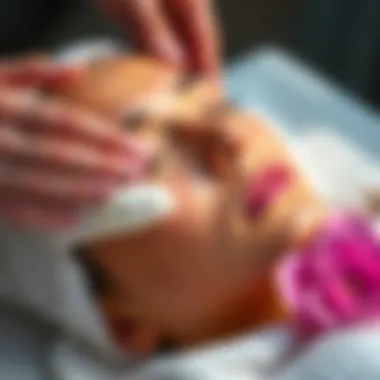Acne Facials with Extractions: A Complete Guide


Intro
Acne is a common skin ailment that affects many individuals, regardless of age or gender. For those eager to clear their skin and regain confidence, acne facials with extractions have emerged as a popular choice. These treatments help in addressing breakouts while refreshing the skin's overall appearance. But what exactly goes into these facials? In this guide, we seek to illuminate the intricacies of acne facials with extractions, examining their processes, benefits, and recommendations for proper aftercare. Understanding this procedure may not just help you achieve clearer skin but also empower you with knowledge about what goes behind the scenes in your skincare routines.
Tips and How-Tos
Skincare Routines for Different Skin Types
Every skin type is unique and demands a customized approach for maximum effectiveness. Here’s a breakdown based on skin types:
- Oily Skin: Look for cleansers that contain salicylic acid. Incorporate a lightweight, oil-free moisturizer to hydrate without adding grease. Regular exfoliation helps to remove dead skin cells that can clog pores.
- Dry Skin: Focus on gentle, hydrating cleansers. Consider use of richer creams that contain hyaluronic acid or glycerin, as they lock in moisture. Avoid harsh scrubs that can lead to irritation.
- Combination Skin: Use a balancing cleanser that addresses both oily and dry areas. A toner with natural astringents can help refine pores without over-drying.
- Sensitive Skin: Stick to fragrance-free products with soothing ingredients like aloe vera or chamomile. Avoid heavy exfoliation and opt for masks that hydrate rather than strip skin.
After-Care for Acne Facials
After the extraction process, certain practices can enhance your skin's recovery:
- Cleanse Gently: Use a mild cleanser to avoid irritating the skin post-treatment.
- Hydrate: Apply a soothing serum or moisturizer to help reduce inflammation.
- Avoid Sun Exposure: After extractions, the skin can be sensitive. Use sunscreen diligently.
- Skip Makeup: Give your skin a break for at least a day to heal properly.
"After care is as essential as the treatment itself; nurture your skin after its ordeal."
Understanding the Extraction Process
To truly appreciate acne facials with extractions, it’s essential to grasp the extraction process itself. A trained professional will utilize specialized tools to carefully remove blackheads and whiteheads. This delicate procedure minimizes skin trauma while effectively clearing blocked pores. Though you may feel a slight discomfort, proper technique ensures that the risk of scarring is minimal.
Benefits of Acne Facials with Extractions
- Deep Cleanse: Removes debris that regular cleansing cannot.
- Prevents Future Breakouts: Regular sessions may help reduce the frequency of eruptions by clearing clogged pores.
- Customized Treatments: Professionals can tailor treatments based on individual skin conditions.
- Enhanced Glow: A facial can lead to a brighter complexion with improved texture.
The world of acne facials with extractions has much to offer, particularly for those who truly seek rejuvenated, clearer skin. By diving into the details of your skincare routine and being mindful of aftercare, you can enhance not just your skin’s appearance, but also its health. For more detailed insights, visiting relevant sources like Wikipedia and Britannica can provide additional information about acne and treatment options.
Understanding Acne and Its Causes
Acne is not just a teenage ailment; it's a condition that can affect people of all ages, including women well into their thirties and beyond. The importance of understanding acne and its causes serves as a foundational pillar for this guide on acne facials with extractions. By grasping the underlying factors that contribute to acne, one can approach treatment with a clearer perspective, making facials and extractions more effective.
Types of Acne
There are several types of acne, each with its own triggers and characteristics:
- Comedonal Acne: This type manifests as small, flesh-toned bumps from clogged pores, commonly known as whiteheads and blackheads. They’re usually not inflamed but can be a source of frustration due to their persistence.
- Inflammatory Acne: This type is typically characterized by red, swollen blemishes, including papules and pustules. The inflammation indicates an immune response, often causing discomfort and tenderness.
- Cystic Acne: Recognized as one of the most severe forms, cystic acne appears as large, painful lumps deep under the skin. These are often caused by hormonal fluctuations and can lead to scarring if left untreated.
- Nodular Acne: Similar to cysts, but they are not filled with pus and feel harder under the skin. These can be painful and require a more aggressive treatment approach.
Understanding these types helps tailor individual skincare routines and treatment methods. Choose your treatment wisely based on the type of acne present.
Common Triggers of Acne
Several common triggers can contribute to the emergence of acne, including:
- Hormonal Changes: Fluctuations during menstruation, pregnancy, or puberty can drastically affect oil production in the skin, often leading to breakouts.
- Diet: Foods with a high glycemic index, dairy, and even some unhealthy fats can exacerbate the condition. Finding a balance in your diet may help reduce the frequency of breakouts.
- Stress: When life throws curveballs, stress can increase cortisol levels, which in turn prompts oil production in the skin.
- Skincare Products: Not all products are made equal. Some can clog pores or trigger allergic reactions, worsening the situation.
Recognizing these triggers is crucial for developing a personalized skincare and treatment plan. Awareness can help in selecting the right procedures and managing breakouts with effective facials.
The Role of Hormones
Hormonal fluctuations are among the most significant contributors to acne. Certain hormones, like androgens, can stimulate the sebaceous glands in the skin, leading to increased oil production. This is particularly notable during:
- Menstrual Cycle: Many women find their skin becomes oilier or breaks out more severely right before their periods.
- Pregnancy: The body experiences a surge in hormones, causing unexpected breakouts.
- Adolescence: Androgens spike during puberty, increasing oil production dramatically.
In some cases, hormonal treatments or specific medications like oral contraceptives can help in regulating these fluctuations, thus mitigating acne breakouts. Understanding these hormonal impacts is essential, not only for addressing current breakouts but also for preventing future occurrences.
Recognizing the intricate relationship between acne and its causes can empower readers to make informed decisions regarding skincare that aligns with their unique skin types and lifestyle choices.
What is an Acne Facial?
In the world of skincare, the term "acne facial" often pops up but many might not fully grasp its significance. Understanding what an acne facial entails is crucial for anyone looking to manage troublesome breakouts effectively. It’s not just a luxury treatment; it serves a specific purpose aimed at addressing the underlying issues that contribute to acne.
Definition and Purpose
An acne facial is a specialized skincare treatment designed to specifically target acne and improve the overall health of the skin. Unlike a regular facial that can be geared towards relaxation or hydration, an acne facial focuses primarily on cleansing pores, removing impurities, and helping to reduce inflammation.


The primary purpose of an acne facial is to treat existing breakouts while also preventing future flare-ups. These facials incorporate a combination of deep cleansing, exfoliation, and extraction tailored to the condition of the client’s skin. The objective is not just to make the skin look better temporarily but also to address the factors that cause acne beneath the surface, promoting long-term skin health.
Components of an Acne Facial
A typical acne facial consists of several key components required for effective treatment. Each part plays a vital role in the overall success of the facial:
- Cleansing: The process usually starts with a thorough cleansing to remove surface makeup, dirt, and oils that could be clogging the pores.
- Exfoliation: This step involves the gentle removal of dead skin cells, often through chemical exfoliants like salicylic acid, to prevent pore blockages that lead to breakouts.
- Steaming: Steaming the face helps to open the pores, making the extraction process easier and more effective.
- Extractions: This is a key aspect of acne facials. Extractions involve the careful removal of blackheads and whiteheads. It's crucial to have this done by a professional to avoid scarring or infection.
- Masking and Treatment: After the extraction, a calming mask is often applied to soothe the skin. Many facials also include targeted treatments like anti-inflammatory or antibacterial agents to further combat acne.
- Moisturizing and Protection: Even acne-prone skin needs hydration. The final step usually includes a lightweight moisturizer and sometimes a sunscreen to protect the newly exposed skin.
Types of Acne Facials
Not all acne facials are created equal. They vary in techniques and formulations based on individual skin types and concerns. Here are a few common types:
- Classic Acne Facial: This generally includes deep cleansing, extraction, and a soothing mask. It’s designed for moderate acne and aims to prevent future breakouts.
- Chemical Peel Facial: This type combines exfoliation and chemical peels to target deeper skin issues. It’s more intensive and ideal for severe acne situations.
- LED Light Therapy Facial: Utilizes blue light therapy to kill acne-causing bacteria, reducing inflammation and breakout frequency. This can be combined with other facial treatments.
- Oxygen Facial: This innovative approach infuses oxygen and nutrients into the skin to rejuvenate and clear breakouts, promoting overall skin health.
Understanding the full breadth of what an acne facial entails empowers individuals to make informed choices about their skincare. Each component plays a vital role in not just treating the symptoms of acne but laying the groundwork for clearer, healthier skin down the line.
"Your skin is a reflection of your lifestyle and the care you put into it."
Being proactive with skin health can drastically change how one feels, making it imperative to choose the right treatment suited to individual needs.
Importance of Extractions
The significance of extractions in acne facials cannot be overstated. Extractions are a critical component when it comes to treating acne, particularly for those dealing with stubborn breakouts. By removing clogged pores and impurities, extractions help restore clarity and health to one’s complexion.
Here are several key benefits and considerations regarding the importance of extractions:
- Clear Pores: The primary aim of an extraction is to clear out excess sebum, dead skin cells, and other debris that lead to acne. This not only helps reduce existing breakouts but also prevents future blemishes.
- Minimized Scarring: Often, improper picking of acne can result in scarring or hyperpigmentation. Professional extractions conducted by an esthetician can effectively minimize the risk of post-inflammatory hyperpigmentation, preserving the skin’s overall appearance.
- Facilitates Healing: Once extractions are performed, the skin’s healing process can commence more effectively. Without blockages, other ingredients used in a facial can penetrate the skin better, ensuring that treatments are more efficacious.
- Boosts Confidence: For many people, battling acne can take a toll on self-esteem. Extractions can lead to immediate improvements in the skin, which boost confidence and promote a sense of well-being.
While the benefits are numerous, it's also crucial to understand when and how extractions should be performed to maximize safety and effectiveness.
What Are Extractions?
Extrctions encompass the process of removing blocked pores, blackheads, and whiteheads that contribute to acne. A trained esthetician typically performs these extractions during a facial or specialized treatment. With a clear understanding of the skin’s needs and concerns, the esthetician uses specific techniques to safely extract impurities without causing damage.
Benefits of Extractions
Some of the most notable benefits of incorporating extractions into your skincare routine include:
- Reduction of Acne: Addressing clogged pores directly correlates with a decrease in the occurrence of spots and inflammation.
- Enhanced Product Absorption: After extraction, the skin is more receptive to treatments like serums and moisturizers, enhancing their overall effectiveness.
- Personalized Skin Care: By analyzing the skin during the extraction process, estheticians can offer personalized advice on future skincare strategies, ensuring better long-term results.
When to Consider Extractions
Not everyone needs extractions on a regular basis, and knowing when to consider them can make all the difference. Here are a few indicators:
- Frequent Breakouts: If you are experiencing constant acne or blackheads, it may be time to consider a professional extracting.
- Accumulated Whiteheads: When whiteheads become persistent, manual extraction might be necessary to clear them safely.
- Lack of Results from Home Care: If at-home skincare doesn’t seem to yield results, consulting an esthetician for extractions may be a wise decision.
"Understanding when to get help can truly be a game changer for your skin journey."
The Extraction Process
The extraction process is central to the efficacy of acne facials. It represents a crucial step for those who wish to not just clean their skin but also to improve its overall appearance and health. By effectively removing blackheads, whiteheads, and other forms of acne, practitioners can significantly lessen the risk of future outbreaks. Understanding the nuances of this process aids individuals in making informed decisions regarding their skincare routines.
Step-by-Step Procedure
The extraction process typically involves a few straightforward steps that can greatly vary based on the severity of acne and the type of facial being performed. Here’s a general breakdown of how it unfolds:
- Preparation: The skin is first cleansed to remove any makeup and surface impurities.
- Steaming: A steam treatment is applied to soften the skin and open up pores, making it easier to extract the acne.
- Extraction: Using either hands or specialized tools, the esthetician gently applies pressure around the clogged pores, coaxing the contents out without damaging surrounding skin.
- Post-Extraction Treatment: Once the extraction is done, the area is treated with soothing serums or masks to minimize any redness or irritation.
- Aftercare Advice: Patients are typically advised on how to care for their skin post-treatment to avoid infections or adverse reactions.
Tools Used for Extractions
Proper tools can make all the difference in the extraction process. These tools not only enhance safety but also improve the effectiveness of extractions. Some commonly used tools include:
- Comedone Extractor: A metal tool with a loop at the end that helps to safely remove blackheads and clogged pores.
- Cotton Swabs: Often used to help apply pressure while extracting without using fingers directly.
- Lancets: These are used for more severe cases, particularly for cysts or deeper cystic acne, providing a clean cut to help release the contents.
- Sterile Gloves: Essential for maintaining hygiene and preventing contamination.
Professional vs. At-Home Extractions
When contemplating extractions, individuals often weigh the option of professional services versus at-home endeavors. Here’s a quick comparison to help in decision making:


- Professional Extractions:
- At-Home Extractions:
- Expert Guidance: Skilled estheticians understand which acne can be safely extracted and those that cannot.
- Proper Techniques: Minimizing the risk of scarring and infection through refined techniques.
- Advanced Tools: Access to sterilized and professional-grade tools that aren't available for at-home use.
- Cost-Effective: Often more economical, as there are no service fees.
- Control Over Timing: No need to fit appointments into your schedule.
- Risks: Without proper techniques or tools, extractions can lead to inflammation or worsen the condition.
Choosing wisely between professional and at-home extractions can significantly impact the skin's health and appearance. Always err on the side of caution and consider consulting a professional to get personalized advice.
"The right extraction technique can transform the skin, restoring clarity and enhancing beauty."
In summary, mastering the extraction process not only helps in managing current acne but can also pave the way for a smoother complexion in the long run. Thus, whether opting for professional treatment or doing extractions at home, understanding the basics can empower individuals to make informed choices.
Potential Risks and Side Effects
Understanding the potential risks and side effects associated with acne facials with extractions is crucial for anyone considering this skincare approach. While the right procedure can significantly improve skin clarity, a lack of awareness about possible complications can lead to undesired outcomes. Accurately identifying and managing these risks allows individuals to make informed decisions and empowers them to take steps that ensure their skincare journey is as safe and effective as possible.
Understanding Risks
When undergoing an acne facial, particularly one involving extractions, several risks come into play. Firstly, there’s the potential for irritation. Extra strong products or aggressive extraction methods can leave the skin feeling sensitive or inflamed. Reaction to these products often varies – some may find their skin merely tinged in redness, while others might experience more noticeable outcomes.
Secondly, there’s also a chance of post-inflammatory hyperpigmentation. This is especially prevalent in individuals with darker skin tones. It occurs when the skin darkens in areas that have been previously inflamed, often as a result of squeezing or picking at acne lesions during extraction. Last but not least, an increased risk of infection looms if extractions are not performed under sterile conditions or if aftercare is neglected.
Furthermore, over-extraction can lead to scarring. It is not uncommon for people to think that deeper extractions yield better results, but this could not be further from the truth. In fact, aggressive techniques can significantly worsen the skin’s condition.
Managing Side Effects
Post-treatment care plays a pivotal role in how the skin responds after an acne facial. Initially, the goal is to minimize discomfort and reduce the risk of complications. One effective strategy is the application of soothing serums or creams, specifically those rich in ingredients like aloe vera or chamomile. These can counteract irritation and promote a calmer complexion.
It’s also important to maintain a hydration strategy post-procedure. Drinking ample water and applying a good moisturizer can keep skin barrier function intact. Moreover, using gentle, non-comedogenic products is necessary to ensure that no new breakouts arise from the facial.
Regular use of sunscreen cannot be overstated. Skin can be more vulnerable to UV rays following treatments, and exposure can further exacerbate pigmentation issues. Thus, it is vital to apply a broad-spectrum sunscreen daily.
Lastly, if you experience significant swelling or pain, it might be prudent to use cold compresses to lessen inflammation effectively. Restoring skin balance is about cautious decision-making in both product application and lifestyle habits in the days following an acne facial.
When to Seek Professional Help
While many side effects can be managed through at-home care, certain situations warrant professional attention. If post-facial symptoms exacerbate beyond expected levels of redness or discomfort, reaching out to a skincare professional is essential. For instance, excessive swelling or prolonged pain could indicate a more severe complication that requires intervention.
Should you notice unusual signs of infection, such as oozing pus or significant erythema persisting longer than a few days, don’t hesitate to consult a dermatologist. Immediate attention may be necessary to prevent further complications, especially if treatment was received in a non-clinical setting.
In general, returning to the esthetician that performed the extraction can be beneficial as they would be familiar with your specific case. This collaborative approach can lead to tailored care based on your unique skin condition.
“An ounce of prevention is worth a pound of cure.”
Taking the necessary precautions before, during, and after an extraction can drastically reduce potential risks.
In summary, understanding the risks, managing side effects diligently, and knowing when to seek professional guidance is crucial for anyone pursuing acne facials with extractions. Balancing these aspects leads to successful long-term skincare outcomes.
Post-Facial Care
Post-facial care is crucial for ensuring that the skin remains healthy and benefits fully from the facial and extractions performed. After the skin has undergone treatment, it is in a sensitive state and requires appropriate care to prevent any adverse reactions and to enhance results. Women of all ages can greatly benefit from understanding this aspect of skincare.
Immediate Aftercare
Right after an acne facial with extractions, it’s normal for the skin to feel a bit tender or flushed. This is part of the healing process. To aid recovery:
- Avoid touching your face: It might be tempting, especially when you feel the need to assess the results, but keep your hands off. This helps minimize the risk of introducing bacteria.
- Skip makeup for a day: Although it can feel inconvenient, letting your skin breathe post-treatment is essential. Makeup can clog pores and irritate sensitive skin.
- Use a gentle cleanser: Stick to mild, soothing cleansers that won't aggravate the skin. Avoid any products with harsh ingredients, like alcohol or fragrances.
- Apply a soothing mask: A hydrating or calming mask can help alleviate redness and irritation. Look for ingredients like aloe vera or chamomile, known for their soothing properties.
Long-term Maintenance
Once the immediate aftercare is taken care of, long-term maintenance becomes necessary to truly keep acne at bay. Establishing a consistent skincare routine not only maintains the benefits of the facial but also improves the overall health of the skin:
- Cleanse regularly: Use a cleanser suitable for your skin type. Daily cleansing is paramount to remove excess oil and prevent clogged pores.
- Moisturize daily: Even oily skin benefits from hydration. Opt for non-comedogenic moisturizers that won't clog pores. Keeping the skin balanced helps maintain clarity.
- Incorporate exfoliation: Use gentle exfoliants weekly to slough off dead skin cells. Chemical exfoliants like glycolic acid can improve skin texture and prevent future breakouts.
- Sunscreen is a must: Protecting the skin from sun damage is essential. Use a broad-spectrum sunscreen daily, as exposure can worsen any post-facial redness.
Recommended Products
Choosing the right products can make a world of difference post-facial. Here are some recommendations:
- For cleansing: Look for CeraVe Foaming Facial Cleanser or La Roche-Posay Toleriane Hydrating Gentle Cleanser. These won’t strip the skin and help maintain its barrier.
- For moisturizing: Options like Neutrogena Hydro Boost Water Gel or Clinique Dramatically Different Moisturizing Gel are effective without clogging pores.
- For exfoliation: Paula’s Choice Skin Perfecting 2% BHA Liquid Exfoliant is great for those struggling with acne, as it penetrates deep into the pores.
- For sun protection: EltaMD UV Clear Broad-Spectrum SPF 46 is a dermatologist favorite; it’s lightweight and specially formulated for acne-prone skin.


In summary, paying attention to post-facial care can significantly influence the results of the treatment. By following these guidelines and investing in the right products, anyone can cultivate smoother, clearer skin that remains healthy over time.
Finding a Qualified Esthetician
Choosing an esthetician isn’t just about getting a facial; it's about entrusting your skin to someone who knows what they’re doing. An experienced professional can make all the difference, especially when it comes to acne facials with extractions. The right esthetician will not only follow a procedure effectively but also tailor it to your unique skin needs. So before you dive in headfirst, let’s break down what you need to keep in mind.
What to Look For
When searching for a qualified esthetician, there are several key factors to consider. Make sure to look for:
- Credentials: Check if they are licensed and certified by a recognized beauty school. This indicates that they have received formal training.
- Experience: Look for estheticians who specialize in acne treatments. Experience isn’t just about years spent in practice but knowing the ins and outs of various skin conditions.
- Hygiene Standards: A clean and sanitized workspace is non-negotiable. Pay attention to how the treatment area looks and whether tools are sterilized properly.
- Approachability: You should feel comfortable asking questions and expressing concerns. A good esthetician is one who listens and addresses your needs professionally.
Questions to Ask During Consultations
Once you've narrowed down your choices, schedule a consultation. This is your opportunity to gauge whether you feel confident in your choice. Here are some important questions:
- What is your experience with acne extractions? Asking this can help you understand their proficiency in handling skin issues.
- What products do you use for the procedures? Know what will be applied to your skin, as certain products can cause reactions.
- How do you customize treatments for different skin types? Everyone’s skin is different; a one-size-fits-all approach isn’t ideal.
- What can I expect during and after the treatment? Understanding the process and expected results can ease anxiety.
- How do you handle emergency skin reactions? A responsive esthetician will be prepared for unexpected issues.
Reviews and Reputation
Finally, before making a commitment, do a bit of homework. The reputation of an esthetician can tell you a lot:
- Online Reviews: Websites like Yelp can offer insights from past clients. Look for patterns in feedback, such as consistent praise or complaints.
- Before-and-After Photos: Many estheticians showcase their work. Look for real results from clients with similar skin issues.
- Referrals from Friends: Word-of-mouth recommendations can be invaluable. Ask friends or family for their personal experiences.
- Social Media Presence: Platforms like Instagram can be useful to gauge their expertise and see current work, as well as any ongoing promotions.
Remember, being diligent in your search can lead to a positive experience not just for one facial but for your entire skincare journey.
Finding the right esthetician may take some time but considering these factors will guide you to someone who prioritizes your skin’s health and well-being. It’s worth the effort, especially when it comes to effective acne care.
Success Stories and Testimonials
Success stories and testimonials serve as pivotal touchpoints in the realm of skincare, particularly when it comes to acne facials with extractions. For many, the journey into effective skin care can be riddled with uncertainty and skepticism. This is where shared experiences become invaluable. Gleaning insights from those who have navigated similar struggles provides not just reassurance but a glimpse into the transformative potential of treatments.
Real Experiences from Clients
Real-life narratives from clients who have undergone acne facials with extractions can paint a vivid picture of the procedure’s impact. For instance, a young woman named Mia reached out after struggling with hormonal acne for several years. "After my first facial, it felt like a weight was lifted off my shoulders – and off my skin!" she said, emphasizing the confidence boost that came with clearer skin. Clients often recount the immediate benefits they observe post-treatment, such as reduced inflammation and a noticeable decrease in breakouts. However, it’s the long-term outcomes that often truly resonate.
- Increased Confidence: Many clients report feeling more self-assured and ready to go makeup-free after their treatments.
- Ongoing Improvement: Continuous sessions often lead to lasting change, as skin texture and tone enhance over time.
- Community Support: Clients frequently build connections through shared testimonies, creating a network of support that encourages ongoing skincare commitment.
Expert Opinions
Experts in the field underscore the efficacy of acne facials with extractions, emphasizing their role in a comprehensive skincare regimen. Dr. Emily Tan, a well-regarded dermatologist, notes, "When performed by skilled professionals, extractions can significantly reduce the risk of future blemishes and foster healthier skin renewal." This sentiment is echoed by many in the industry, highlighting the importance of prudent technique and the application of personalized skincare solutions.
- Tailored Treatments: Experienced estheticians assess each individual's skin type and condition, adapting the extraction methods to suit unique needs.
- Expert Guidance: Professionals not only provide immediate results but also offer tailored advice on maintaining skin health post-treatment.
Case Studies
Case studies add another layer of depth, illustrating both the process and outcomes achieved through acne facials with extractions. Take the case of Sarah, whose struggle with cystic acne left her feeling defeated. Following a series of targeted facials over a few months, her skin not only cleared up but also showed remarkable improvement in terms of texture and tone.
- Before and After: Documenting visual changes can be incredibly persuasive, displaying tangible results that resonate with prospective clients.
- Quantitative Results: In certain studies, follow-ups can reveal a drop in inflammatory acne lesions by up to 70% after a series of sessions, underscoring the technique’s effectiveness.
"My skin isn’t just clearer; it’s thriving. The facials and the extractions have changed my life," said Sarah, encapsulating how professional interventions can elevate one’s skincare journey.
These narratives, insights, and documented experiences bolster the credibility of acne facials with extractions, encouraging potential clients to embark on their skincare journey with confidence.
End
In this comprehensive exploration of acne facials with extractions, we have journeyed through various facets of the topic, illustrating their significant role in effective skincare. This conclusion serves as a synthesis of essential elements that speak to the procedure's efficacy, benefits, and considerations that users should regard. Understanding the nuances involved not only allows for informed decisions but also promotes a healthy approach to skincare routines.
Recap of Key Points
- Acne Facials Defined: They are specialized treatments aimed at clearing and soothing acne-prone skin, focusing on eradication of blemishes through professional techniques.
- Importance of Extractions: Properly performed extractions can remove clogged pores, reducing breakouts and promoting clearer skin texture.
- Post-Care Essentials: Immediate aftercare, including using soothing products, is vital in ensuring that the skin heals properly and thrives post-extraction.
- Long-Term Considerations: Incorporating sustainable practices into your daily skincare regimen is essential for enduring results and maintaining skin health.
Encouragement for Continued Care
Taking part in acne facials with extractions is just one piece of the skincare puzzle. It’s crucial to adopt a consistent skincare routine that nourishes your skin daily, helping in both immediate and long-term care. Regular check-ins with your skincare professional can facilitate tailored recommendations geared towards any changing skin conditions. This ongoing journey necessitates patience. Good skincare not only enhances physical appearance but also has positive effects on self-esteem.
Next Steps in Skincare
Consider the following steps to enhance your skincare regimen post-facial:
- Identify Products that Suit Your Skin Type: Look for non-comedogenic formulations specifically designed for acne-prone skin to prevent future breakouts.
- Travel Light with Makeup: If you can, minimize the use of heavy makeup immediately after your facial, allowing your skin the chance to breathe and recover.
- Regularly Schedule Facials: Depending on skin conditions, consider visiting your esthetician every few weeks. Consistency will foster greater results.
- Educate Yourself Continuously: Stay informed about new treatments, products, and techniques in skincare by following reputable beauty and dermatology sources online.
"Beauty is about being comfortable in your own skin."
With the information presented here, you can navigate the world of acne facials with confidence, targeting your skin concerns effectively and wisely. The road to clear skin is paved with knowledge and self-care.







